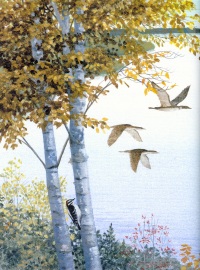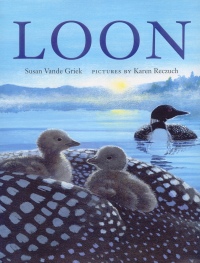| ________________
CM . . . . Volume XVIII Number 11 . . . . November 11, 2011
excerpt:
Each autumn, it is with sadness that I bid farewell to the majestic loons who turn their beaks to the south and fly away to avoid the harsh northern winters. Groundwood Books’ new picture book, Loon, will help to pass the time until the loons return in the spring. Susan Vande Griek’s poetic text and Karen Reczuch’s lavish illustrations complement one another to create a beautiful book to be enjoyed again and again. Loon depicts the life-cycle of Common Loons (Gavia immer), beginning with two chicks hatching from their eggs through until, years later, they are ready to raise chicks of their own. The informative text and detailed illustrations combine well to provide a wealth of information for elementary school readers and an enjoyable reading and viewing experience for nature lovers of all ages. Reczuch’s double-page spreads are lovely. The colour palette chosen for the acrylic on canvas paintings reflect the changing seasons, capturing the heat of summer and the chill of autumn. The artwork is presented from a variety of viewpoints, creating visually interesting illustrations. By the artist’s placing a dominant image of a loon in the near foreground of most of the paintings, the illustrations draw the reader into the world of the loon.
Reczuch’s double-page spreads are lovely. The colour palette chosen for the acrylic on canvas paintings reflect the changing seasons, capturing the heat of summer and the chill of autumn. The artwork is presented from a variety of viewpoints, creating visually interesting illustrations. By the artist’s placing a dominant image of a loon in the near foreground of most of the paintings, the illustrations draw the reader into the world of the loon.The lyrical, occasionally rhyming, text lends beauty to the book, as well as detail and information. The word choices are evocative; however, I would have preferred more care to avoid anthropomorphism. I found repeated references to Mama and Papa distracting, as were such lines as: I understand that when loons call, one of the things they are doing is communicating their locations to one another. But the “be back soon” comment was off-putting. I would simply have preferred the text to discuss loons communicating, rather than putting words into their mouths. Despite this criticism, the text is generally strong and reflects the author’s admiration for her subject. At the end of the book, two pages of text are dedicated to providing additional information, including identification of the five types of loons. A distribution map would have been a nice addition but was noticeably absent. Much of the additional information is appropriately dedicated to discussion of threats to loons’ conservation. Loon is a delightful celebration of nature, generally, and the regal loons specifically. As well as being worthy of a place on Canadian bookshelves, this book would make a very nice gift for summer visitors to the north who want to take with them a lasting memento of their time in Canada. Highly Recommended. Gregory Bryan is a professor of literacy education and children’s literature in the Faculty of Education at the University of Manitoba.
To comment
on this title or this review, send mail to cm@umanitoba.ca.
Copyright © the Manitoba Library Association. Reproduction for personal
use is permitted only if this copyright notice is maintained. Any
other reproduction is prohibited without permission.
NEXT REVIEW |
TABLE OF CONTENTS FOR THIS ISSUE
- November 11, 2011.
AUTHORS |
TITLES |
MEDIA REVIEWS |
PROFILES |
BACK ISSUES |
SEARCH |
CMARCHIVE |
HOME |
